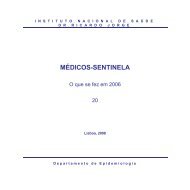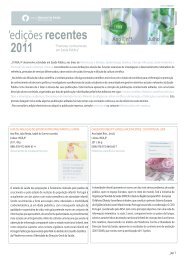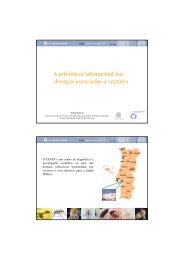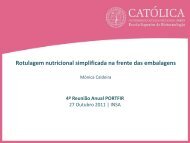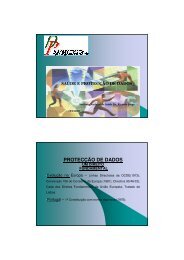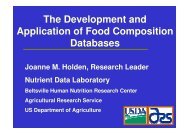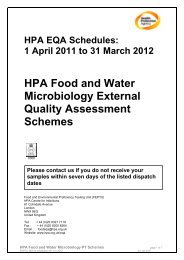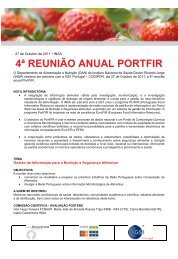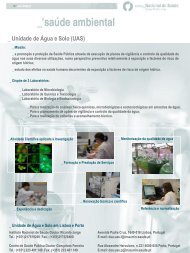European Society of Mycobacteriology - Instituto Nacional de Saúde ...
European Society of Mycobacteriology - Instituto Nacional de Saúde ...
European Society of Mycobacteriology - Instituto Nacional de Saúde ...
You also want an ePaper? Increase the reach of your titles
YUMPU automatically turns print PDFs into web optimized ePapers that Google loves.
PP-1<br />
EVALUATION OF THE HIGH-THROUGHPUT REPETITIVE-SEQUENCE-BASED PCR<br />
DIVERSILAB SYSTEM IN M. tuberculosis MOLECULAR EPIDEMIOLOGY STUDIES<br />
Miotto Paolo, Baldan Rossella, Cirillo Daniela M.<br />
Emerging Bacterial Pathogens Unit, San Raffaele Scientific Institute, Milan – ITALY<br />
PCR-based methods have been <strong>de</strong>veloped to simplify and reduce the time required for genotyping M. tuberculosis by standard<br />
approaches based on IS6110-Restriction Fragment Length Polymorphism (RFLP). Of these, MIRU-VNTR complemented<br />
with spoligotyping has been proposed as an alternative. Repetitive-sequence-based PCR (rep-PCR) is useful for<br />
generating DNA fingerprints <strong>of</strong> diverse bacterial species. Rep-PCR amplicon fingerprints represent genomic segments<br />
lying between non-coding repetitive sequences. A commercial system (Diversilab, Biomerieux) that electrophoretically<br />
separates rep-PCR amplicons on micr<strong>of</strong>luidic chips, and provi<strong>de</strong>s computer-generated readouts <strong>of</strong> results has been<br />
adapted for use with Mycobacterium species. The ability <strong>of</strong> this system to type M. tuberculosis was evaluated in comparison<br />
with spoligotyping and MIRU-VNTR in two different panels.<br />
First, we evaluated a 35 strains panel by MIRU-15 complemented with spoligotyping and Diversilab rep-PCR. Results<br />
were analyzed with MIRU-VNTRplus database for spoligo-MIRU, and with Diversilab S<strong>of</strong>tware for rep-PCR using two<br />
different algorithms (Pearson Correlation [PC] and Kullback-Leibler [KL]). Threshold for clusters was fixed at 98% <strong>of</strong><br />
similarity for rep-PCR. MIRU-15 showed a clustering rate <strong>of</strong> 11.4% whereas the rep-PCR reported a clustering rate <strong>of</strong><br />
28.6% (PC) and 17.1% (KL). The discriminatory power (Hunter-Gaston discriminatory in<strong>de</strong>x [HGDI]) for spoligo-MIRU-<br />
15 resulted 0.983 whereas for rep-PCR was 0.978 (PC) and 0.983 (KL).<br />
We also compared the two techniques on a panel composed by 8 closely related strains from a probable outbreak. In<br />
this case the rep-PCR showed a discriminatory power <strong>of</strong> 0.571 (PC) and 0.679 (KL), compared to a HGDI <strong>of</strong> 0.643 for<br />
spoligo-MIRU-15. Nevertheless, clustering rate for MIRU-15 was 50.0% whereas rep-PCR algorithms showed a clustering<br />
rate <strong>of</strong> 100.0% (PC) and 62.5% (KL), respectively. To un<strong>de</strong>rstand the meaning <strong>of</strong> the discrepancies still found between<br />
spoligo-MIRU-15 and rep-PCR, analysis <strong>of</strong> epi<strong>de</strong>miological data for the clustered patients will be taken in consi<strong>de</strong>ration.<br />
Preliminary data obtained by Diversilab suggest that the KL algorithm is more appropriate for M. tuberculosis typing analysis.<br />
Nevertheless, even if rep-PCR results analyzed by KL algorithm showed a discriminatory power similar to MIRU-15,<br />
clustering rate remains higher. This new technique could be useful for a routine use in clinical laboratories for real-time<br />
genotyping and laboratory contaminations control.<br />
<strong>European</strong> <strong>Society</strong> <strong>of</strong> <strong>Mycobacteriology</strong> | 30 th Annual Congress | July 2009 | Porto - Portugal<br />
75



